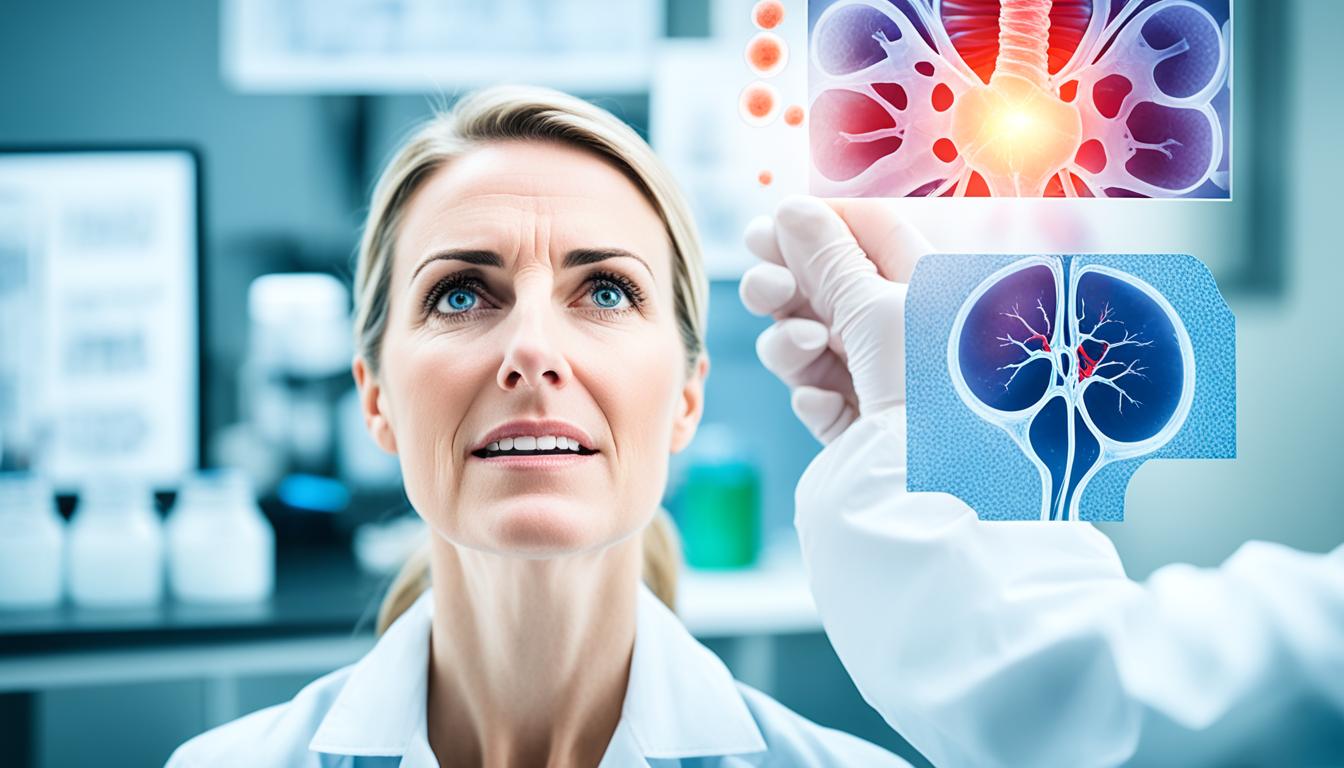Chronic pelvic pain is a common issue, affecting about 10% of women worldwide. It brings severe pain during periods, sex, bowel movements, or urination. This condition can also cause bloating, nausea, and tiredness. Sometimes, it leads to feelings of depression, anxiety, and can even affect fertility.
Endometriosis is one condition linked to this pain. It occurs when tissue grows outside the uterus. This can result in swelling, the formation of scar tissue, and various types of lesions. Yet, diagnosing and treating chronic pelvic pain early is a challenge, especially in low-income areas.
Key Takeaways:
- Chronic pelvic pain affects approximately 10% of reproductive-age women and girls globally.
- It is characterized by severe pain during periods, sexual intercourse, bowel movements, and/or urination.
- Other symptoms include abdominal bloating, nausea, fatigue, and sometimes depression, anxiety, and infertility.
- Endometriosis is one of the chronic diseases associated with pelvic pain.
- Early diagnosis and effective treatment of chronic pelvic pain are limited in many settings.
Endometriosis: A Common Cause of Chronic Pelvic Pain
Endometriosis affects about 10% (190 million) of women and girls of child-bearing age worldwide. It happens when tissue like the uterus lining grows outside the uterus. This can lead to chronic pelvic pain, a key sign of endometriosis.
Mostly, women with endometriosis feel severe pelvis pain during their periods. The pain can also happen during sex, urinating, or a bowel movement. It really affects their daily life and happiness, often lasting a long time.
Besides pain, this condition can show itself in other ways, too. Some women have lots of bleeding during periods or in between. Trying to get pregnant can also be hard. Plus, you might feel bloated, sick, tired, sad, or anxious.
The exact cause of endometriosis is not really clear yet. But, some believe that certain things in the body, like the way periods flow, may play a part. Because it’s so complex, it can be hard to diagnose early. Its signs can look like other pelvis issues.
Getting diagnosed and treated early is key to dealing with endometriosis. If you’re having unusual pelvic pain, see a doctor. Getting the right tests can lead to the right treatment. With treatments, symptoms can get better, and life can improve.
Understanding Endometriosis: Key Points
- Endometriosis is a chronic disease affecting 10% of reproductive-age women worldwide.
- It is characterized by the growth of tissue similar to the uterine lining outside the uterus.
- Symptoms include severe pelvic pain, pain during intercourse, and pain during urination or defecation.
- Other symptoms may include heavy bleeding during periods, fertility issues, bloating, fatigue, depression, and anxiety.
- The cause of endometriosis is not yet fully understood, but theories suggest retrograde menstruation, cellular metaplasia, and the spread of stem cells.
- Early diagnosis is challenging due to the overlap of symptoms with other conditions, emphasizing the importance of seeking medical attention.
In the next section, we will explore the various diagnosis and treatment options available for managing chronic pelvic pain caused by endometriosis.
Diagnosis and Treatment Options for Chronic Pelvic Pain
Diagnosing chronic pelvic pain requires look into a patient’s menstrual symptoms and pelvic pain history. There are no specific tests to diagnose it, but doctors use different methods to learn more.
Ultrasonography, a method that uses sound waves, is common. It helps doctors see if there are any problems like ovarian cysts or fibroids in the pelvic area.
Magnetic resonance imaging (MRI) also helps. It creates detailed pictures using magnets and radio waves. This method offers a close look at the pelvis to find problems like endometriosis.
If more clarity is needed, doctors might suggest a surgical procedure. This includes using a camera to look inside the abdomen. They can take samples of tissue for further tests.
After diagnosis, there are many treatment options. Medicines like NSAIDs can reduce pain and swelling. Hormonal treatments, including birth control, can help with menstrual pain.
Some cases might need surgery for lasting pain relief. Removing endometrial lesions or scar tissue can help. In severe situations, a hysterectomy might be an option after consulting a specialist.
Complementary treatments like physiotherapy offer benefits. They can strengthen muscles and improve pelvic function. Acupuncture or stress-reduction techniques could also help.
Early detection and treatment are crucial. By spreading awareness and encouraging specialized care, we can make a difference. This ensures those with chronic pelvic pain can find relief and enjoy a better quality of life.
Table: Comparison of Diagnosis and Treatment Options for Chronic Pelvic Pain
| Diagnosis Methods | Treatment Options |
|---|---|
| Ultrasonography | Medications (NSAIDs), hormonal medicines |
| Magnetic Resonance Imaging (MRI) | Surgical removal of endometriosis lesions, adhesions, and scar tissue |
| Surgical or laparoscopic visualization | Hormonal management, fertility medicines and procedures, complementary treatments (physiotherapy, acupuncture) |
Managing chronic pelvic pain well means tailoring care to each person. Doctors can use different tests and treatments to reduce pain. This approach aims to improve life quality and support patients in enjoying their lives fully.
Conclusion
Chronic pelvic pain, often caused by endometriosis, significantly impacts millions of women across the globe. It brings on intense pain, makes people tired, and can lead to feelings of sadness and worry. These issues can also affect a woman’s ability to have children.
Catching it early and treating it well are key parts of managing this pain. While a full cure isn’t known, there are ways to control the pain and help women feel better. This includes using medicines, hormone treatments, and surgeries.
It’s also key to talk about chronic pelvic pain more and support research. This helps everybody understand the condition better and find new ways to diagnose and treat it. By doing this, we can work towards improving the lives of those with chronic pelvic pain.

